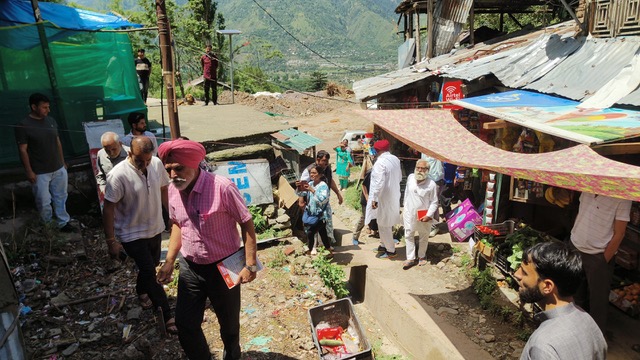In India’s deeply polarised polity, where dissent is punished as anti-national, when the hysteria of blood-lust nationalists makes war between Pakistan and India the new normal, to speak of peace is likely to be branded as treason. Yet, in May as India and Pakistan were caught in a feeding frenzy of war hysteria, slowly peace activists on both sides of the border broke out of their fearful isolation and appealed to stop the war. Dormant cross border peace forums revived dialogue and asserted with gathering momentum that peoples on both sides of the border wanted peace. The edge and urgency of the call for the resumption of severed diplomatic and people-to-people exchanges was driven by alarm at the new template of war as the first option in an escalating military confrontation between two nuclear armed neighbours with structural conflict legacies
On April 22, a heinous terrorist attack had shattered the state-sponsored narrative of ‘normalisation’ in Pahalgam, Kashmir, leaving 25 Indian tourists and a local Kashmiri who intervened dead. Promptly linking the terror attack with Pakistan, based on the established pattern of cross border proxy terror attacks, India established the new normal, suspending and weaponising the Indus Waters Treaty, which had survived three India-Pakistan wars. Amid media-amplified war jingoism, India activated the country’s new strategy of militarily striking at the presumed source of ‘terror’ infrastructure. It escalated into four days of full-scale air missile volleys with a nuclear threat overhang. The welcome, though unexplained, ceasefire (confused by US President Donald Trump’s contested mediation claim), outraged chest thumping nationalists who fused the border war with the communal ‘war’ within. The two states have cross-border co-ethnic religious communities, where the minority in one is the majority in the other, i.e. Hindus in Pakistan and Muslims in India In ascendant Hindu majoritarianism, Muslim citizens were vilified as the proxy other, the ‘enemy’, and all Kashmiris were considered collectively guilty and targeted for collective punishment.
Ironically, there were no calls for politically engaging with the core dispute of Kashmir between these two post-colonial partitioned independent states. The Hindu right’s political project of Kashmir’s assimilation by abrogating the special autonomy clause Art.370 in the Constitution had provoked Pakistan to dismantle diplomatic ties and the trust-building architecture of trade and transport. The terror attack precipitated the expulsion of each other’s citizens, severing ties of blood and intimacy.
War criers yelled , ‘No Country for Pacifists’ at the once vibrant cross border peace constituency that had dared to envision people-to-people exchanges re-scripting a peace narrative. The embedding of Hindu majoritarian discourses and the ascendance of the military in the civil–military equation in Pakistan had isolated peace activists, weakened by the passing away of stalwarts such as Mubashir Hasan, I A Rehman, Tapan Bose and Admiral Ramdas. Had peace activism retreated to the South Asian diaspora in the form of the South Asia Peace Action Network ( SAPAN)?
But above the drums of war, and despite the high cost of ‘anti-national’ dissidence, a myriad initiatives emerged. Veteran social activist and cross-border campaigner Sandeep Pandey convened a slew of virtual dialogues, tapping the organisational access of Pakistani activist and SAPAN convener Beena Sarwar. These were among the first exchanges between well-known but also new peace activists, academics, scientists, media persons, artists, women and social justice advocates and former political leaders.
Then followed the Pakistan-India Forum for Peace and Democracy (PIPFPD) cross-border dialogue. For over two decades PIPFPD has inspired tens of thousands to forge a politically informed peace movement. The conversation on Counting the Cost of the Pakistan-India ‘War’ that took place on June 18 2025 unpacked the humanitarian, social, political, military, and economic aspects and re-centered the discussion on people and their perspectives. The dialogue brought the plight of the Kashmiris in the border’s killing fields, who had been reduced to collateral damage and further victimized in the mass arrests that followed the terror attack, from the margins to centre stage. Kashmir Times editor Anuradha Bhasin and journalists from both sides of the Kashmir divide spoke of the 21 civilians killed and the draconian arrests that followed the terror attack.
Present at the dialogues were both old familiars and new voices. The Indo-Pakistan nuclear physicists Pervez Hoodbhoy, A H Nayar and Atul Gurtu took on the teaser of whether the nuclear threat drove the ceasefire, and questioned effective deterrence between two nuclear armed neighbours and what a nuclear fallout would mean. Journalists Imtiaz Alam and Ram Reddy, academics Taimur Rahman and Radha Kumar, artists Seema Kirmani and Anand Patwardan, social justice and rights activists M Vijayan and Tahira Abdullah and public figures like Syeda Hameed and Mani Shankar Aiyar, dared to speak frankly, not about which nation had scored, but to better understand the contexts and complexities. The academic Taimur Rahman encapsulated the India-Pakistan structural conflict, Marvi Srimed demystified the ‘smoking gun’ evidence of the presence of Pakistani Generals at the funerals of the dead ‘terrorists”. Indian journalist Zia us Salam spoke of being Muslim in India, while Indian lawyer Shah Rukh Alam struggled against a reductionist framing of identity. Dismay was shared about the media’s hyper war-gaming, and concern over the budgetary distortions and sacrifice of development priorities.
Aside from the cross border dialogues and South Asian people-to-people series of webinars, the sustained track two or independent intervention of O.P Shah of the Centre for Peace and Progress was an exceptional and courageous initiative. These hybrid and virtual track two conversations involved former Ministers, diplomats, national security advisors, politicians and peace activists. The realist perspective dominated, but while normalisation was considered a distant prospect, the consensus was clear on reviving and sustaining diplomatic dialogue and even people-to-people links.
Among the peace statements issued, the joint call of feminists from India and Pakistan was of particular significance. Some 7750 women called for a rejection of the logic of war rooted in nationalism, toxic masculinity and colonial-era borders. The feminists found India’s patriarchal branding of its military operation following the Pahalgam attack as Operation Sindoor (a vermillion mark symbolising Hindu married woman) particularly objectionable and denounced it as manipulating the pain of the women widowed in the terror attack and weaponising it into a war cry.
With the triumphalism of war narratives revived in India and Pakistan’s Independence Day commemorations, peace groups in both countries were determined to continue the 30 years tradition of the candlelight vigil on both sides of the border on 14 -15 August. Although Indian authorities blocked access to the Attari border post, some 200 Pakistan activists kept alive the tradition at the Wagah border post. This was backed up by events organised by the Hind Pakistani Dosti Manch (India-Pakistan Friendship Forum) in Amritsar while in Lahore the South Asia Free Media Association (SAFMA) and left parties held a seminar entitled ‘Make Peace the New Normal’. The cross border peace constituency is not dead.
Rita Manchanda is a researcher, writer and human rights activist specialising in conflicts and peace building in South Asia with a particular focus on the role of civil society, in particular of women, in building peace in the region. Professor Manchanda is the Senior Executive and Research Director of the NGO “South Asia Forum for Human Rights (SAFHR) and has published widely on the rights of minorities and refugees and on civil society organisations’ strategies in the face of shrinking spaces.





